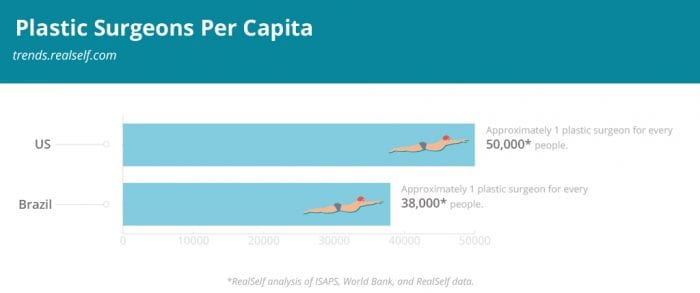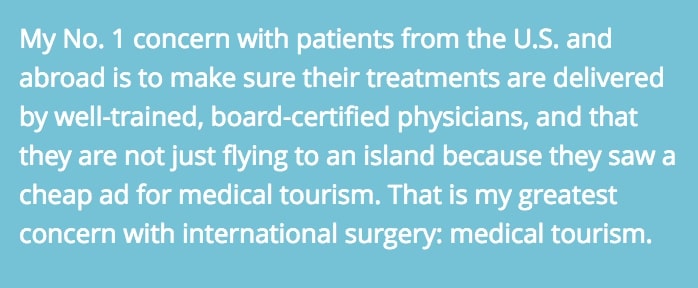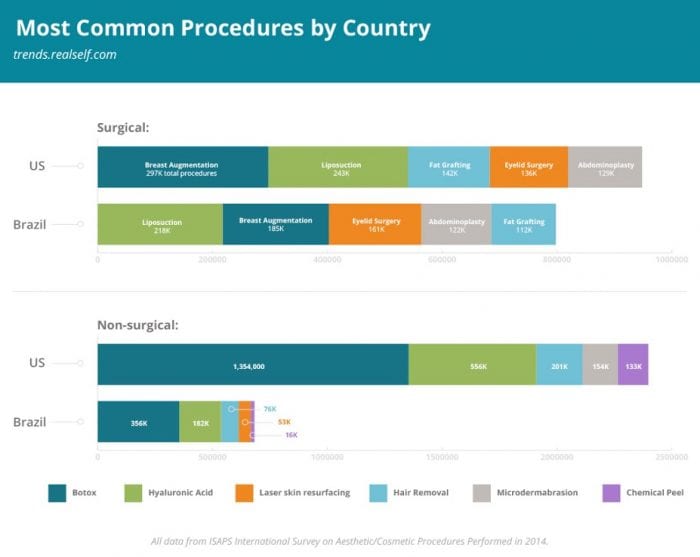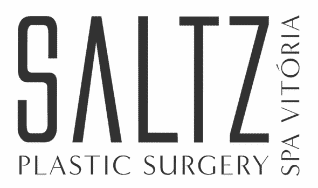RealSelf interview with Dr. Renato Saltz
With the Olympics kicking off August 5 in Rio de Janeiro, we compared top trends in two of the world’s largest plastic surgery markets — the U.S. and Brazil.
According to the latest International Society of Aesthetic Plastic Surgery (ISAPS) survey data from 2014, the U.S. led in the total number of surgical procedures performed with 1.48 million (15% of the worldwide total). That means about 1 in every 215 Americans had a surgical procedure done (assuming they had only one).
However, it is actually more common for people in Brazil to have a procedure performed. The country had 1.34 million surgical procedures (14% of the worldwide total), which means approximately 1 in every 155 Brazilians had a cosmetic surgical procedure done that year.
Americans lead when it comes to non-surgical cosmetic procedures. Approximately 1 in 125 in the U.S. had a non-surgical procedure performed in 2014. In Brazil, that number was 1 in 290.
There is arguably no one better to talk about the similarities and differences between the two cultures than Dr. Renato Saltz. A native of Brazil who moved stateside to complete his medical residency, Dr. Saltz stayed in the U.S. to teach and develop his practices in Salt Lake City and Park City, Utah.

Dr. Saltz is also the president elect of ISAPS. He takes over leadership of the organization in October, and he says that globalization has all but completely blurred national boundaries when it comes to beauty.
Dr. Saltz talked to us about plastic surgery and other non-surgical treatments:
RealSelf: Based on the latest ISAPS data from 2014, the top two treatments of interest in the U.S. and Brazil are breast augmentation and liposuction. How have you seen interests change in both markets over the years?
Dr. Saltz: I came here in 1980, did my training and started practicing, and every time I went to a Brazilian meeting, the aesthetic ideals were completely different, not just in Brazil, but all of South America.
Breast augmentation was not popular at all when I left in the 1980s and early ’90s, and it was always a very small chest and projected buttocks in Brazil because biologically that’s how they are. Here [in the U.S.], it was opposite. Maybe in the past 10 to 20 years, we’ve been seeing that change with Brazilians getting larger breasts.
One that’s really taken off in both countries is the butt lift and butt augmentation. You go to our meetings now, and the Brazilian butt lift is one of the hot topics.
Even patients in Utah, and I get them [coming in] from California, say “You’re Brazilian, you know how to do this.” It’s actually just a name — the butt lift started in America, with Jennifer Lopez and Kim Kardashian.
RS: Is the trend here to stay?
Dr. Saltz: I think so. I get a lot of South American patients, I visit there a lot for my family, and I always pay attention to what my colleagues are doing there. There is a lot of butt augmentation.
For Brazilian women, the ideal shape was always less breasts, more buttocks. In the U.S., the ideal was large breasts and very small buttocks, and now that’s a change. Even in conservative practices like Utah, I see a lot of patients coming in not for such large breasts, but for fat injections for their buttocks.
RS: How do you see social media affecting it?
Dr. Saltz: A lot has to do with the internet and globalization. Look at the ideals for men and women: they’re not Brazilian or American — it’s a global look. It’s so crazy and so fast, all these selfies. Everybody’s now sharing their bodies with everybody else, and it’s grown exponentially.
We don’t have an ideal like Grace Kelly or Marilyn Monroe — those were American faces. Not anymore, you look at Megan Fox, look at some intriguing faces in Vanity Fair, and they are the ideals of beauty right now. Injecting cheeks, making the lower face very angular, it’s just a whole different ballgame.
RS: Interest in both countries is growing for non-surgical procedures. Which ones continue to trend?
Dr. Saltz: Definitely the fillers big, big time, not just in Brazil. I just got back from Stockholm and Mykonos. For the Swedish, German, French, Greek, Turkish, it’s everywhere. There are no boundaries there. Botox is huge, as you know.
The other procedure that’s very popular is CoolSculpting in Brazil, but also in Sweden, in France, all over Europe. CoolSculpting is a very, very successful technology. It works very well, our whole staff had it done. We’re getting a fourth machine this third quarter. It’s crazy.
RS: What other non-surgical treatments are trending?
Dr. Saltz: Cellfina for cellulite. Before we never had anything that worked — massages, lotions, potions — now you have a device that actually works. These are big in most plastic surgeons’ practices.
Non-surgical is just going to grow. If you look at the growth in the past 18 years, surgical has grown, but not by a lot. The number of non-surgical procedures done in this country is crazy. The ISAPS stats on non-surgical treatments are almost unbelievable for many reasons: they’re less invasive, safer, less expensive, and there are things that really work.
RS: What are the top concerns in each market for people pursuing a procedure?
Dr. Saltz: I think they are very similar. There’s a lot of exchange of knowledge and techniques between Brazilian and American plastic surgeons. They come to our meetings here. The American-Brazilian Aesthetic Meeting gathers 250 to 300 plastic surgeons from all over the world. Things like that bring us closer together, our training is similar, skills are similar, and the procedures, the patients, are becoming more and more identical, and we all have to put safety first.

RS: What attitudes about plastic surgery do you think the U.S. could adopt from Brazil? And vice versa?
Dr. Saltz: I think Brazilians are much more open. Aesthetic surgery has been a very open discussion and debate since I decided I was going to be a plastic surgeon in high school in the early ’70s — everybody talked about it. Then I did my training at the University of Alabama in Birmingham, and it was very hush-hush — you don’t talk about your aesthetic procedures.
In Brazil, it’s available for every level of the population, and that’s not so much the case here. You can pay on a different payment plan in Brazil. Here in the U.S., it’s not for everyone. You can pay with credit cards, or you can get a loan, but it’s not wide open for the entire population.
RS: Could it be made more accessible in the U.S.?
Dr. Saltz: We don’t have payment plans, and I don’t know if anybody is offering that. We offer CareCredit, and that has opened aesthetic surgery to a lot of people. You qualify over the phone, and it’s a open credit for surgery, so the surgeons have the payment before the procedure, the patient pays every month to company. It’s a very popular program in the U.S., but in Brazil, you get off at the airport, and you see all these magazines offering payment plans — it’s like buying a car.
ISAPS 2014 Data for U.S. and Brazil Markets:

Plastic surgery and non-surgical treatments continue to be popular in the U.S. and Brazil, No. 1 and 2 in the total number of aesthetic procedures (surgical and non-surgical), according to ISAPS.
While plastic surgery is relatively common in both countries, perceptions and attitudes regarding it vary widely. A Brazilian native who now lives in the U.S. told us that it’s “very common” for most Brazilians to have a procedure, and they don’t hide that fact.
“Most of my friends and some of my family members have done plastic surgery,” she said via email. “Usually they are very open, since the procedure was done to correct something they were not happy about, and they became more confident with their figure. Beauty is one of the most important things for Brazilians.”
Additionally, she said that she has been talking to her Brazilian family and friends “more and more about non-invasive solutions such as fat reduction, like Vanquish, as well as Botox and the stretch-mark treatment Carboxytherapy.”
Of course, social media is an influencer, too. “Social is big,” she says. “Most of the time we get interested in a procedure after hearing someone talking about it. Also seeing pictures of results usually makes us very interested. Instagram is definitely the most popular.”



